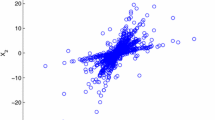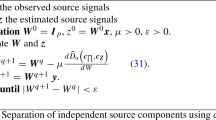Abstract
The techniques of Blind Separation of Sources (BSS) are used in many Signal Processing applications in which the data sampled by sensors are a mixture of signals from different sources, and the goal is to obtain an estimation of the sources from the mixtures. This work shows a new method for blind separation of sources, based on geometrical considerations concerning the observation space. This new method is applied to a mixture of two sources and it obtains the coefficients of the unknown mixture matrix A and separates the unknown sources, So. Following an introduction, we present a brief abstract of previous work by other authors, the principles of the method and a description of the algorithm, together with some simulations.
Access this chapter
Tax calculation will be finalised at checkout
Purchases are for personal use only
Preview
Unable to display preview. Download preview PDF.
Similar content being viewed by others
References
Jutten, C., Hérault, J., Comon, P., Sorouchiary, E.: Blind separation of sources, Parts I, II, III. Signal Processing, 24(1), 1991, 1–29.
P. Comon, Independent Component Analysis, A new concept?, Signal Processing, 36(3), 1994, 287–314.
E. Moreau and O. Macchi, New self-adaptive algorithms for source separation based on contrast functions, Proceedings of IEEE Signal Processing Workshop on Higher-Order Statistics, Lake Tahoe (USA), 1993, 215–219.
M. Gaeta and J.L. Lacoume, Source separation without a priori knowledge: the maximum likelihood solution, Proceeding of EUSIPCO’ 90, Barcelona (Spain), 1990, 621–624.
K. Matsuoka, M. Ohya and M. Kawamoto, A neural net for blind separation of nonstationary signals, Neural Networks, 8(3), 1995, 411–419.
A.J. Bell and T J. Sejnowski, An information-maximisation approach to blind separation and blind deconvolution, Neural Computation, 7, 1995, 1129–1159.
C.G. Puntonet, A. Prieto, C. Jutten, M. Rodríguez and J. Ortega, J, Separation of sources: a geometry-based procedure for reconstruction of n-valued signals, Signal Processing, 46(3), 1995, 267–284.
C.G. Puntonet, M. Rodríguez-Alvarez and A. Prieto, A geometric method for blind separation of sources.. Proceedings of the IASTED International Conference on Artificial Intelligence and Soft Computing. Banff (Canada), 1997, 372–375.
C.G. Puntonet, M. Rodríguez-Alvarez, A. Prieto and B. Prieto, Separation of speech signals for nonlinear mixtures. Proceedings of the 5 th International Work-Conference on Artificial and Natural Neural Networks (IWANN’99) Alicante (Spain), 1999, 665–673.
Author information
Authors and Affiliations
Editor information
Editors and Affiliations
Rights and permissions
Copyright information
© 2001 Springer-Verlag Berlin Heidelberg
About this paper
Cite this paper
Rodríguez-álvarez, M., Puntonet, C.G., Rojas, I. (2001). Separation of Sources Based on the Partitioning of the Space of Observations. In: Mira, J., Prieto, A. (eds) Bio-Inspired Applications of Connectionism. IWANN 2001. Lecture Notes in Computer Science, vol 2085. Springer, Berlin, Heidelberg. https://doi.org/10.1007/3-540-45723-2_92
Download citation
DOI: https://doi.org/10.1007/3-540-45723-2_92
Published:
Publisher Name: Springer, Berlin, Heidelberg
Print ISBN: 978-3-540-42237-2
Online ISBN: 978-3-540-45723-7
eBook Packages: Springer Book Archive




